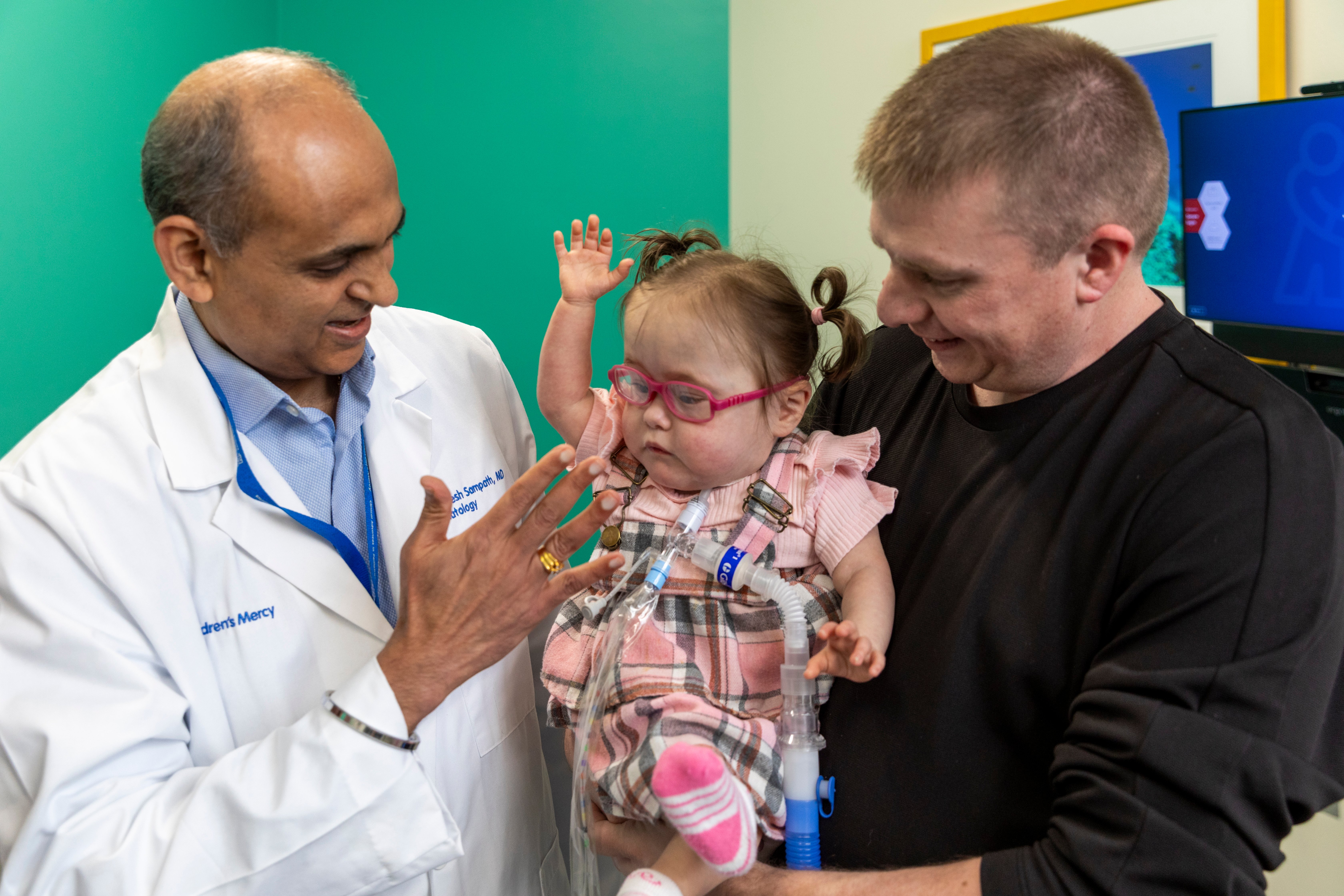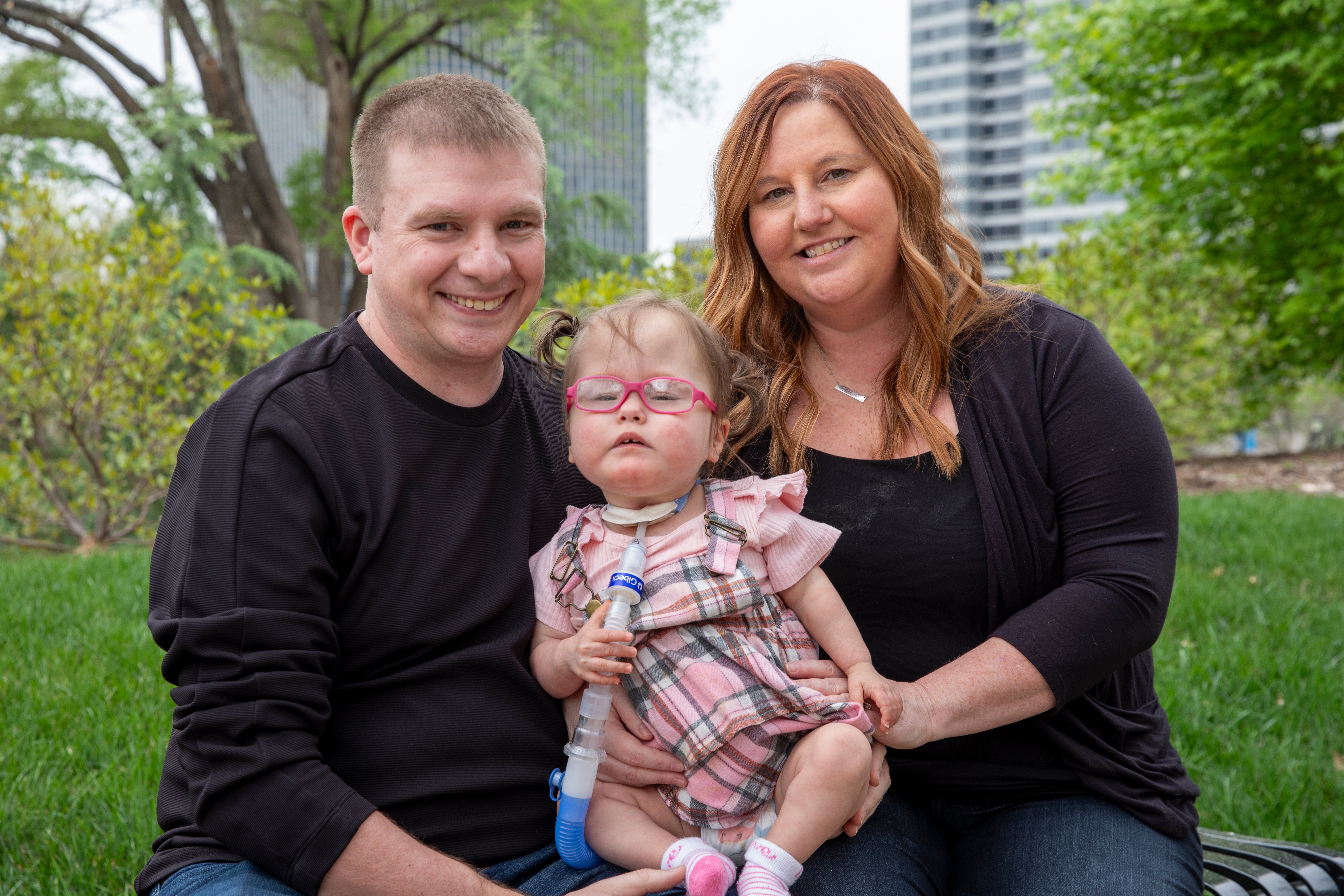Venkatesh Sampath, MBBS, MRCPCH
Sosland Endowed Chair in Neonatal Research; Director, Neonatal Diseases Research Program; Director, Donald Thibeault Lung & Immunology Laboratories; Professor of Pediatrics, University of Missouri-Kansas City School of Medicine; Research Associate Professor of Pediatrics, University of Kansas School of Medicine
Full Biography
He’s both a neonatologist and a leading scientist, but Venkatesh Sampath, MBBS, MRCPCH, might more accurately be labeled a “bridge builder.”
Dr. Sampath, the Sosland Endowed Chair in Neonatology Research and the Director of the Neonatal Diseases Research Program, is passionate about bridging the gap between scientific discoveries and clinical applications.
“I love looking after babies, helping them and their families through difficult times on the clinical side,” he said. “But when I go to my lab, I love finding out why babies get sick. And through research, we can help them.”
Now approaching a decade at Children’s Mercy, Dr. Sampath said he wasn’t originally planning on pursuing research, but a fellowship at Cincinnati Children's Hospital pushed him in that direction.
“After a lot of struggle initially, I think I got the hang of it,” he said.
NIH grants accelerate disease research
Just in the last calendar year, Dr. Sampath has received nearly $3 million in extramural grant funding for his research into two serious diseases affecting premature infants.
The first — a $446,100 grant from the Eunice Kennedy Shriver National Institute of Child Health and Human Development — is for translational research into the use of the drug ciclesonide (CIC) to prevent bronchopulmonary dysplasia (BPD), a chronic lung disease. BPD affects infants born before 30 weeks gestation and can cause long-term respiratory and neurodevelopmental impairments — even death. Preterm infants are often at risk for BPD because typical interventions — such as oxygen delivery and breathing machines — can injure different lung cells and disrupt lung development, thus causing BPD.
I love looking after babies, helping them and their families through difficult times on the clinical side. But when I go to my lab, I love finding out why babies get sick. And through research, we can help them.
The traditional treatment is steroids, but synthetic steroids such as dexamethasone can suppress brain development and growth in vulnerable preterm babies. Dr. Sampath said the new drug doesn’t cross the blood-brain barrier and has no effect on brain size or linear growth, unlike traditional synthetic steroids.
“We hope to change the paradigm from high risk/high reward to very low risk/high reward,” he said. “And that’s potentially a game-changer for preterm babies.”
After working with models for four years, this latest grant will allow him to begin a phase 1 clinical trial.
“Successful testing of our hypothesis will pave the way for a large, multicenter randomized control trial of CIC therapy in premature infants to prevent BPD,” he said.
The second grant — a $2.5 million grant from the National Institute of Diabetes and Digestive and Kidney Diseases, announced in February 2025 — is to study necrotizing enterocolitis (NEC), a devastating gastrointestinal disease with up to 20% mortality. Specifically, Dr. Sampath is studying the single immunoglobulin interleukin-1 related receptor (SIGIRR) gene, which regulates inflammation in the intestine. Because premature infants lack a developed intestinal mucosal barrier, they’re at a higher risk of developing NEC.

While the cause of NEC is not yet fully understood, Dr. Sampath and his team will look at how genetic mutations in the SIGIRR gene alter the intestinal mucosal barrier function, which allows bacteria to invade the intestine and bloodstream, contributing to NEC and sepsis.
“If you have healthy interactions between good bacteria and host genes, the gut is healthy and both the bacteria and the babies thrive,” he said. “But if something goes wrong, you get all these diseases. And that’s really the focus of our study.”
In addition to the two grant-funded studies, Dr. Sampath is also studying how genetic mutations may play a role in the development and severity of herpes simplex virus (HSV) in neonates, and how injury to lung endothelial cells (cells that line blood vessels) contribute to lung disease in preterm babies.
Sampath combines research with patient care
All this research is more than just academic, of course, as Dr. Sampath is always looking for ways to translate his team’s discoveries into clinical practice. The learnings from his HSV research, for example, has already changed the clinical protocol at Children’s Mercy — adding an immunology and genetic workup for every baby born with severe HSV and boosting the prophylaxis procedures.
“It’s all about understanding the science, building on new ideas and then trying to bring it back to babies and families here,” he said.

As a practicing neonatologist, he’s often out of the lab and at the bedside, working to help preterm infants and their families while also learning how serious diseases are impacting real people. That’s where he first met Hazel, born at just 24 weeks and weighing only 13.2 ounces.
After birth, Hazel developed NEC and was immediately transferred by helicopter to Children’s Mercy, where she underwent emergency surgery for a perforated intestine.
“By the time we drove up there, she was coming out of surgery,” said Hazel’s mother, Nikki. “One of the surgeons even said, ‘She's lucky to be alive. Most babies don't make it.’ We weren't understanding the gravity of what NEC was or what that meant.”
In addition to the NEC, Hazel was also dealing with BPD, a debilitating chronic lung disease for which she eventually needed a tracheostomy. All of Hazel’s challenges made interactions with their new daughter extremely limited as she required a breathing tube during the first eight months of her life, Nikki said. Nikki and her husband, Cory, had to sit very still, with the lines and wires taped carefully to their shoulders when holding her, so as not to disrupt anything, she said.
“Even in her crib, she could only be turned gently from side to side or lie flat on her back — there was no freedom of movement. It was incredibly hard. We wanted to comfort her, to rock her, but all we could do was stay still and let her hear our voices and feel our heartbeat, give her our presence, without movement.”
Over the course of her 378-day stay in the NICU, Hazel and her family got to know many of the clinicians at Children’s Mercy, including Dr. Sampath.
“He was one of the rotating physicians who would see Hazel,” Nikki said. “He was so personable and always came out to the bedside. If we had questions, he had no problem following back up, making sure at the end of the day we were comfortable and understood what was going on. That really meant a lot.”

It was while caring for Hazel that Dr. Sampath first approached her parents about participating in a research trial for NEC. Since the study only required a few blood draws, Nikki and Cory said the decision was an easy one to make.
“There are going to be other babies like Hazel, and if we can help and not risk Hazel's life in the same moment, we absolutely were open to it,” Nikki said. “Hazel wouldn't be where she is without research. We were so lucky she was alive. So, we were like, ‘Yeah, if we can help, yes.’ And we just trusted [Dr. Sampath] was going to do great things.”
Whether it was updates on Hazel’s hospital care or explanations about the research study, the parents felt comforted by Dr. Sampath’s approach every step of the way.
“He was a calming presence,” Cory said. “He didn't sugarcoat anything, but he helped ease our minds a little bit and explained it in a way that was maybe a little less scary than some news could be.”
Passion for patients leads to brighter future for all
For Dr. Sampath, his work is always about amplifying the impact of the research and reaching the most babies and families.
“I can take care of 15 or 20 babies at one time,” he said. “But when you share knowledge, you’re impacting the care of 100 babies. And when that knowledge gets published, then you’re taking care of thousands of babies. When you spread good research or clinical practice around, you can impact a much larger population.”
He [Dr. Sampath] was so personable and always came out to the bedside. If we had questions, he had no problem following back up, making sure at the end of the day we were comfortable and understood what was going on. That really mean a lot.
He said he’s excited to build on the groundbreaking work done every day at Children’s Mercy, especially while working with his talented teammates and members of the Neonatal Diseases Research Program.
“The lab team is both my hands and sometimes my brains. I love working with them, and we’ve grown together,” he said. “I’m really passionate about everything I do. I love the connection between babies and research. And we are well on the way to making our Neonatal Research Program a top center for translational research in the country.”
